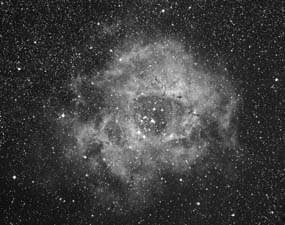Return to Index |
Previous Image |
Next Image |
The Rosette Nebula's circular symmetry
gives it an appearance similar to that of an opened rose. This nebula,
located in Monoceros, is 3,000 light years from Earth and is larger than
one degree in the sky. It is estimated to be about 130 light years in
diameter. The Rosette Nebula is an emission nebula, meaning that it consists
of clouds of high temperature gas. The hydrogen atoms in the cloud are
heated when ultraviolet light shines on them, and then in turn they emit
radiation as they cool. The stars in the Rosette Nebula form an open cluster,
meaning that they are not gravitationally bound and will disperse in a
relatively short time. The gas and dust at the core of the nebula have
been pushed away from the central stars by radiation pressure and stellar
wind, making the center relatively hollow. This process will continue
until the nebula dissipates.
(Copyright Anglo-Australian Observatory)
References:
http://seds.lpl.arizona.edu/billa/twn/n2237x.html
http://www.aao.gov.au/images/captions/uks009.html
Object |
Distance from Earth |
Wavelength |
Rosette Nebula |
3,000
light years |
Optical |

